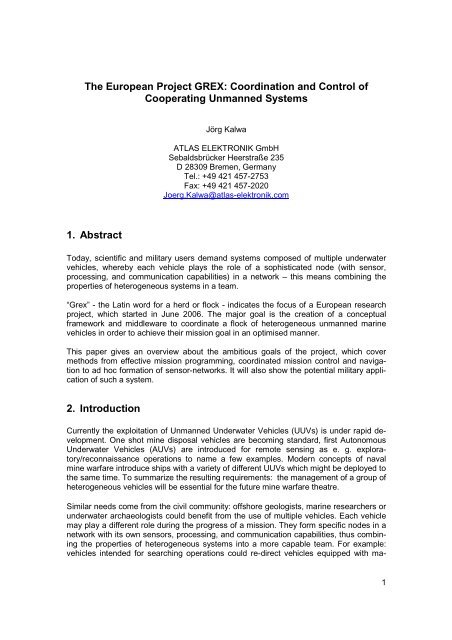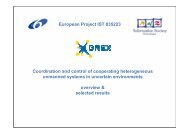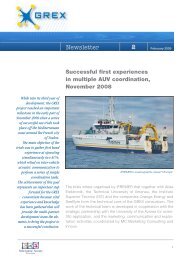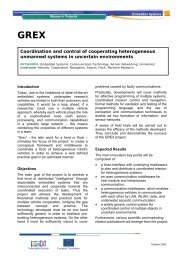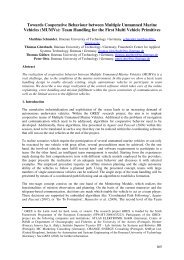The European Project GREX: Coordination and Control of ...
The European Project GREX: Coordination and Control of ...
The European Project GREX: Coordination and Control of ...
Create successful ePaper yourself
Turn your PDF publications into a flip-book with our unique Google optimized e-Paper software.
<strong>The</strong> <strong>European</strong> <strong>Project</strong> <strong>GREX</strong>: <strong>Coordination</strong> <strong>and</strong> <strong>Control</strong> <strong>of</strong><br />
Cooperating Unmanned Systems<br />
1. Abstract<br />
Jörg Kalwa<br />
ATLAS ELEKTRONIK GmbH<br />
Sebaldsbrücker Heerstraße 235<br />
D 28309 Bremen, Germany<br />
Tel.: +49 421 457-2753<br />
Fax: +49 421 457-2020<br />
Joerg.Kalwa@atlas-elektronik.com<br />
Today, scientific <strong>and</strong> military users dem<strong>and</strong> systems composed <strong>of</strong> multiple underwater<br />
vehicles, whereby each vehicle plays the role <strong>of</strong> a sophisticated node (with sensor,<br />
processing, <strong>and</strong> communication capabilities) in a network – this means combining the<br />
properties <strong>of</strong> heterogeneous systems in a team.<br />
“Grex” - the Latin word for a herd or flock - indicates the focus <strong>of</strong> a <strong>European</strong> research<br />
project, which started in June 2006. <strong>The</strong> major goal is the creation <strong>of</strong> a conceptual<br />
framework <strong>and</strong> middleware to coordinate a flock <strong>of</strong> heterogeneous unmanned marine<br />
vehicles in order to achieve their mission goal in an optimised manner.<br />
This paper gives an overview about the ambitious goals <strong>of</strong> the project, which cover<br />
methods from effective mission programming, coordinated mission control <strong>and</strong> navigation<br />
to ad hoc formation <strong>of</strong> sensor-networks. It will also show the potential military application<br />
<strong>of</strong> such a system.<br />
2. Introduction<br />
Currently the exploitation <strong>of</strong> Unmanned Underwater Vehicles (UUVs) is under rapid development.<br />
One shot mine disposal vehicles are becoming st<strong>and</strong>ard, first Autonomous<br />
Underwater Vehicles (AUVs) are introduced for remote sensing as e. g. exploratory/reconnaissance<br />
operations to name a few examples. Modern concepts <strong>of</strong> naval<br />
mine warfare introduce ships with a variety <strong>of</strong> different UUVs which might be deployed to<br />
the same time. To summarize the resulting requirements: the management <strong>of</strong> a group <strong>of</strong><br />
heterogeneous vehicles will be essential for the future mine warfare theatre.<br />
Similar needs come from the civil community: <strong>of</strong>fshore geologists, marine researchers or<br />
underwater archaeologists could benefit from the use <strong>of</strong> multiple vehicles. Each vehicle<br />
may play a different role during the progress <strong>of</strong> a mission. <strong>The</strong>y form specific nodes in a<br />
network with its own sensors, processing, <strong>and</strong> communication capabilities, thus combining<br />
the properties <strong>of</strong> heterogeneous systems into a more capable team. For example:<br />
vehicles intended for searching operations could re-direct vehicles equipped with ma-<br />
1
nipulators to extend their scope <strong>of</strong> activity to rescuing missions. Some systems could<br />
watch other systems at work to record the operations using video or they could serve as<br />
navigation aids or communication relay stations. Multiple vehicles allow surveying wider<br />
areas in less time, simultaneously obtaining time <strong>and</strong> space resolutions that are otherwise<br />
unachievable. Combining pre-existing vehicles into a team will make research more<br />
effective <strong>and</strong> will lead to completely new applications.<br />
To coordinate <strong>and</strong> h<strong>and</strong>le such groups <strong>of</strong> vehicles the research project <strong>GREX</strong> has been<br />
created within the 6 th framework <strong>of</strong> the <strong>European</strong> Commission. <strong>The</strong> 3 years project<br />
started in June 2006 <strong>and</strong> will end in June 2009.<br />
<strong>The</strong> main goal <strong>of</strong> the project is to achieve a first level <strong>of</strong> distributed “intelligence” through<br />
dependable embedded systems that are interconnected <strong>and</strong> cooperate towards the coordinated<br />
execution <strong>of</strong> tasks. Thus the project will witness the development <strong>of</strong> theoretical<br />
methods <strong>and</strong> practical tools for multiple vehicle cooperation, bridging the gap between<br />
concept <strong>and</strong> practice. <strong>The</strong> technology developed must be on one h<strong>and</strong> sufficiently generic<br />
in order to interface pre-existing heterogeneous systems. On the other h<strong>and</strong> it must<br />
be sufficiently robust to cover problems caused by faulty communications.<br />
Practically, developments will cover methods for effective programming <strong>of</strong> multiple systems,<br />
coordinated mission control <strong>and</strong> navigation, formal methods for validation <strong>and</strong> testing<br />
<strong>of</strong> the programming language, <strong>and</strong> the use <strong>of</strong> perception <strong>and</strong> communication techniques<br />
to enable ad hoc formation <strong>of</strong> information- <strong>and</strong> sensor-networks. A series <strong>of</strong> field<br />
trials will be carried out to assess the efficacy <strong>of</strong> the methods developed. <strong>The</strong>y conclude<br />
<strong>and</strong> demonstrate the success <strong>of</strong> the <strong>GREX</strong> project.<br />
3. Mission Scenarios<br />
<strong>The</strong> objectives <strong>of</strong> the <strong>GREX</strong> project are well rooted in an in-depth analysis <strong>of</strong> potential<br />
user requirements. <strong>The</strong>re are three types <strong>of</strong> mission scenarios which are the basis for<br />
discussion <strong>and</strong> specifications. <strong>The</strong>se mission scenarios envisioned take into account<br />
challenging problems in the field <strong>of</strong> marine science. <strong>The</strong>y also bring out the ever increasing<br />
important role that marine technology is having in terms <strong>of</strong> affording marine scientist<br />
the tools that are needed to explore <strong>and</strong> exploit the ocean. We place the focus on missions<br />
for which the following basic ingredients are required:<br />
• <strong>The</strong> missions require the use <strong>of</strong> several “intelligent” autonomous vehicles<br />
equipped with appropriate instrumentation.<br />
• <strong>The</strong> inter-vehicle coordination <strong>and</strong> mission control is dynamic <strong>and</strong> highly dependent<br />
on the type <strong>of</strong> information obtained as the missions unfold.<br />
<strong>The</strong> mission can be extended into various related tasks as can be found e. g. in military<br />
missions.<br />
Three typical scenarios are described in detail on the following pages.<br />
2
Scenario 1 – the quest for hydrothermal vents<br />
Marine scientists (including geologists <strong>and</strong> biologists) have by now gathered considerable<br />
knowledge about deep water hydrothermal vents <strong>and</strong> their intriguing ecosystems<br />
<strong>and</strong> chemosynthetic life forms. <strong>The</strong> vents hold considerable potential for the biotechnological<br />
industry <strong>and</strong> are a window on the evolution <strong>of</strong> life on planet Earth. <strong>The</strong>y are also<br />
spectacular <strong>and</strong> generate widespread public interest.<br />
Besides the well known deepwater vents there are strong indications that hydrothermal<br />
vents exist at 150 m depth, around the D. João de Castro Bank [1], but this has not been<br />
proved yet. <strong>The</strong>re is a need worldwide to develop efficient methodologies to detect intermediate<br />
depth vents because <strong>of</strong> their far reaching implication in the study <strong>of</strong> the biological<br />
responses to an environment wedged between deep <strong>and</strong> shallow waters.<br />
Fig. 1: Scenario drawing: the quest for hydrothermal vents<br />
<strong>The</strong> mission proposed is based on the knowledge that vents produce methane <strong>and</strong> that<br />
methane does not dissolve quickly in the water. This in turn allows for its detection <strong>and</strong><br />
for the measurement <strong>of</strong> the gradient <strong>of</strong> its concentration using methane sensors. <strong>The</strong><br />
two step mission starts with a fast survey <strong>of</strong> a given area using a fleet <strong>of</strong> AUVs equipped<br />
with acoustic sensors. <strong>The</strong> map produced will allow for the examination <strong>of</strong> geological<br />
features (acting as indicators <strong>of</strong> the possible presence <strong>of</strong> vents) that will guide the choice<br />
<strong>of</strong> smaller inspection areas. Once a smaller area is found, a fleet <strong>of</strong> vehicles equipped<br />
with methane sensors can be deployed, as depicted. <strong>The</strong> vehicle baseline configuration<br />
is such that spatial estimates <strong>of</strong> the gradient <strong>of</strong> the methane concentration can be com-<br />
3
puted cooperatively. It is up to the fleet to manoeuvre so as to seek the region <strong>of</strong> higher<br />
concentration, <strong>and</strong> thus the localisation <strong>of</strong> the vent.<br />
<strong>The</strong> scenario described requires multiple vehicle motion coordination based on the type<br />
<strong>of</strong> information (methane concentration) that is acquired as the mission progresses. <strong>The</strong><br />
mission poses formidable challenges to systems designers due to the need to develop a<br />
distributed, multi-vehicle coordination scheme (requiring robust vehicle localization,<br />
navigation, <strong>and</strong> control) in the presence <strong>of</strong> stringent underwater communication constraints.<br />
This task is closely related to applications in anti terror warfare, where a team <strong>of</strong> vehicles<br />
shall locate under water explosives attached to a ship-hull or detect under water penetration<br />
<strong>of</strong> harbour areas.<br />
Scenario 2 – download data from tagged fish<br />
One <strong>of</strong> the project partners is involved in a project that uses passive <strong>and</strong> active telemetry<br />
devices on fishes. <strong>The</strong>se tags are able to log environmental data <strong>and</strong> to send acoustic<br />
signals which allow tracking <strong>of</strong> the marked fish. <strong>The</strong> studies have significantly improved<br />
the underst<strong>and</strong>ing <strong>of</strong> fundamental phenomena such as the dispersal, spawning dynamics<br />
or thermoregulatory mechanisms <strong>of</strong> marine animals, but most importantly they are<br />
opening a new window in the framework <strong>of</strong> the spatial management <strong>of</strong> marine living resources.<br />
Critical impacts include the use <strong>of</strong> spatial behaviour in fisheries stock assessment<br />
<strong>and</strong> the design <strong>of</strong> Marine Protected Areas.<br />
Field experience proved to be difficult to get the data back from the tagged fish. A swam<br />
<strong>of</strong> AUVs in cooperation with one or more surface crafts would be able to perform a<br />
search task to locate a tagged fish. Two or more autonomous surface vehicles (ASVs)<br />
move in the same direction, while keeping a desired formation pattern (e.g. side by side).<br />
Equipped with acoustic receivers, they sweep the water column as they move along <strong>and</strong><br />
listen to the sounds emitted by the acoustic tags. By using more than one ASV, the position<br />
<strong>of</strong> the tags can be determined with adequate precision.<br />
Upon detecting one or more tags, one <strong>of</strong> the ASVs communicates to a group <strong>of</strong> AUVs<br />
the positions <strong>of</strong> those tags using an acoustic communication network. It is then up to the<br />
AUVs to track the target <strong>and</strong> stay within the communication range with a given accuracy<br />
(typically, not worse than 100 meters) for a period <strong>of</strong> time. <strong>The</strong> period should be sufficient<br />
enough to download the tag data. Upon conclusion <strong>of</strong> the fish-data download task,<br />
the AUVs manoeuvre back to the vicinity <strong>of</strong> the steadily moving ASVs, to wait for further<br />
instructions.<br />
4
Fig. 2: Scenario drawing: download data from tagged fish<br />
This methodology dispenses with the deployment <strong>of</strong> fixed underwater units <strong>and</strong> is specially<br />
suited to scan a given volume <strong>of</strong> the ocean in a fast <strong>and</strong> expedite manner. In this<br />
interesting scenario, the AUVs are equipped with acoustic pingers for navigation purposes.<br />
<strong>The</strong>y are further equipped with acoustic modems allowing for direct communications<br />
with the ASVs. We thus have all the ingredients <strong>of</strong> a complex, albeit powerful network<br />
involving different players, whereby the ASVs play the triple role tag position detectors,<br />
AUV position detectors, <strong>and</strong> communications relay stations from the AUVs to a<br />
support ship or even to shore. <strong>The</strong> benefit <strong>of</strong> such a communication relay is that it can<br />
be deployed <strong>and</strong> monitored from shore. Underwater experiments can be viewed <strong>and</strong>/or<br />
controlled by more scientific users than using a ship <strong>of</strong>fshore. Costs can be reduced <strong>and</strong><br />
the number or quality <strong>of</strong> experiments increased.<br />
Scenario 3 - marine habitat mapping<br />
Habitat maps <strong>of</strong> the marine environment contain data on the bathymetry <strong>and</strong> nature <strong>of</strong><br />
the seabed as well as on the type <strong>and</strong> localization <strong>of</strong> biological assemblages. <strong>The</strong>se are<br />
the key to an in-depth underst<strong>and</strong>ing <strong>of</strong> the distribution <strong>and</strong> extent <strong>of</strong> marine habitats.<br />
Knowledge <strong>of</strong> the distribution <strong>of</strong> marine habitats serves to establish sensible approaches<br />
to the conservation needs <strong>of</strong> each habitat <strong>and</strong> to facilitate a better management <strong>of</strong> the<br />
marine environment. This subject is receiving widespread attention worldwide because<br />
<strong>of</strong> its far reaching implications <strong>and</strong> has led to the definition <strong>of</strong> a number <strong>of</strong> guidelines <strong>and</strong><br />
directives for the study <strong>and</strong> preservation <strong>of</strong> marine habitats. At the <strong>European</strong> level, for<br />
example, Annex I <strong>of</strong> the celebrated EU Habitats Directive establishes that marine habitats<br />
classified as Special Areas <strong>of</strong> Conservation need special assessment in order to<br />
verify their accordance with the <strong>European</strong> Union requirements.<br />
5
Fig. 3: Scenario drawing: marine habitat mapping<br />
<strong>The</strong> scientific mission scenario for marine habitat mapping proposed here was greatly<br />
influenced by <strong>and</strong> aims to automate <strong>and</strong> improve “classical” procedures that are normally<br />
used by marine scientists. <strong>The</strong> key ideas can be explained by referring to figure 3.<br />
For simplicity <strong>of</strong> exposition, we start by focusing on the ASV/ROV ensemble in the figures,<br />
where the ROV is connected to the ASV through a thin umbilical for fast data<br />
transmission. In this scenario, the ASV executes a lawn mowing manoeuvre above the<br />
seabed automatically, while the ROV executes a similar manoeuvre in cooperation with<br />
the ASV. Using this set-up, the ROV transmits pictures <strong>of</strong> the seabed back to the support<br />
ship (<strong>and</strong> thus to the scientist in charge) via a radio link installed on-board the ASV.<br />
A number <strong>of</strong> AUVs stay dormant either on the seabed or at the sea surface. Upon detection<br />
<strong>of</strong> interesting features on the seabed by the scientist in charge, a signal is sent to a<br />
selected member <strong>of</strong> the AUV fleet (via an acoustic communication link installed on-board<br />
the ASV), to dispatch it to the spot detected so as to map the surrounding region in great<br />
detail. Meanwhile, the ASV/ROV ensemble continues to execute the lawn mowing manoeuvre<br />
in search <strong>of</strong> other sites <strong>of</strong> interest. With the methodology proposed, sites that<br />
are interesting from an ecological viewpoint are easily detected along the trajectory <strong>and</strong><br />
those sites are selectively mapped in high resolution.<br />
To execute the challenging mission above, a number <strong>of</strong> autonomous vehicles must work<br />
in cooperation, under high level human supervision. This entails the development <strong>of</strong> advanced<br />
systems for coordinated motion control <strong>and</strong> navigation in the presence <strong>of</strong> severe<br />
underwater communication constraints, together with the respective s<strong>of</strong>tware <strong>and</strong> hardware<br />
architectures.<br />
6
Especially this scenario is also relevant for military application as it is directly related to a<br />
Search-Classify-Map mission <strong>of</strong> a coastal region using various sensors. <strong>The</strong> vision <strong>of</strong> an<br />
AUV, which systematically maps an area while processing data on board <strong>and</strong> activating<br />
an identification or mine disposal vehicle on dem<strong>and</strong>, is also incorporated in this use<br />
case.<br />
<strong>The</strong> Challenge<br />
In summary the overall challenge <strong>and</strong> necessary result <strong>of</strong> the project is to establish <strong>and</strong><br />
realize basic technologies for networked <strong>and</strong> cooperating heterogeneous unmanned marine<br />
vehicles:<br />
• A user-interface with underlying middleware to plan, check <strong>and</strong> distribute a coordinated<br />
mission for heterogeneous objects – <strong>and</strong> for post mission analysis,<br />
• A generic control system for coordinated control <strong>of</strong> multiple objects in an uncertain<br />
environment including aspects <strong>of</strong> mission alterations on the fly <strong>and</strong> triggered<br />
action,<br />
• A swarm navigation solution which enables team members to estimate the position<br />
within the swarm as basis for coordinated control <strong>and</strong> communication network,<br />
• A generic communication middleware, which enables heterogeneous vehicles to<br />
communicate with each other by LAN, radio <strong>and</strong> underwater acoustic communication,<br />
• Life sea trials to validate performance <strong>of</strong> the result shall conclude the project.<br />
4. <strong>The</strong> Consortium <strong>and</strong> Share <strong>of</strong> Work<br />
<strong>The</strong> Consortium is composed <strong>of</strong> 9 Partners which share the work under coordination <strong>of</strong><br />
the German company ATLAS ELEKTRONIK GmbH.<br />
<strong>GREX</strong> will start with a short definition phase. <strong>The</strong> Instituto do Mar at the University <strong>of</strong><br />
the Azores, which is dedicated to biological research in the underwater domain, is in<br />
charge to define scenarios <strong>and</strong> requirements, from which development <strong>and</strong> trials will be<br />
deducted.<br />
Scientific Methodical Analysis <strong>and</strong> Research will mainly be performed by the Institute <strong>of</strong><br />
Robotics <strong>of</strong> the Instituto Superior Técnico (IST) (Portugal) <strong>and</strong> the Technische Universität<br />
Ilmenau, Faculty <strong>of</strong> Computer Science <strong>and</strong> Automation in Germany. Both Institutes<br />
combine their theoretical backgrounds to achieve the ambitious goals.<br />
<strong>The</strong> Bulgarian SME Sciant, experts in embedded systems <strong>and</strong> communications, will develop<br />
the middleware for inter-process <strong>and</strong> inter-vehicle communication as well as for<br />
dynamic networking.<br />
7
<strong>The</strong> French research institute Ifremer with its operational experience in underwater<br />
communication will lead the specifications <strong>of</strong> communication in the <strong>GREX</strong> system <strong>and</strong><br />
provide their Aster X -Vehicle for evaluative tests.<br />
To test the functionality <strong>of</strong> the joint modules, an overall simulation will be developed by<br />
Seebyte Ltd., UK. <strong>The</strong>y will also be responsible to create the GUI for planning <strong>and</strong><br />
analysis <strong>of</strong> the coordinated mission.<br />
<strong>The</strong> scientific/technical part <strong>of</strong> the project, described above, will be framed by an intensive<br />
marketing. INNOVA uses their experience in market studies <strong>and</strong> exploitation plans<br />
for <strong>GREX</strong>. MC Marketing Consulting will coordinate the dissemination <strong>and</strong> promotion<br />
during the project <strong>and</strong> prepares the web presentation.<br />
IST/ISR ASV Delphim<br />
IST/ISR AUV Infante<br />
Fig. 4: Selected unmanned marine vehicles available to the project<br />
ATLAS UUV SeaWolf<br />
Ifremer AUV Aster x<br />
8
5. <strong>The</strong> <strong>GREX</strong> team<br />
<strong>The</strong> developments in the project will be tested using the existing vehicles <strong>of</strong> the consortium<br />
(Fig. 4 above), which really fulfil the heterogeneous approach. Each vehicle differs<br />
in their sensor equipment, their autonomous capabilities, dynamic properties, <strong>and</strong> programming/comm<strong>and</strong><br />
language.<br />
To form a <strong>GREX</strong>-enabled vehicle there is the need to install an additional computer<br />
hardware which runs common modules which are responsible for the coordination, navigation,<br />
<strong>and</strong> communication tasks, see fig 5. Core element is the Team H<strong>and</strong>ler. This<br />
module holds the team mission plan <strong>and</strong> is responsible for proper execution <strong>and</strong> possible<br />
re-planning activities. <strong>The</strong> control <strong>of</strong> coordinated behaviour will also be resident here.<br />
<strong>The</strong> latter functionality will be supported by the team navigation unit which holds the actual<br />
or estimated position <strong>of</strong> each vehicle in the group. <strong>The</strong> information is distributed via<br />
the acoustic communication, backed by range measurements to other vehicles.<br />
Vehicle specific<br />
console<br />
<strong>GREX</strong><br />
Offline<br />
Interface<br />
<strong>GREX</strong><br />
Interface<br />
Module<br />
Proprietary<br />
vehicle<br />
s<strong>of</strong>tware<br />
( unchanged)<br />
- Vehicle guidance<br />
- Navigation data<br />
- Payload data<br />
Mission Plan<br />
H<strong>and</strong>ler<br />
Mission<br />
Monitoring<br />
Fig. 5: <strong>GREX</strong> s<strong>of</strong>tware module overview<br />
<strong>GREX</strong> Planning<br />
Console<br />
Team H<strong>and</strong>ler<br />
Coordinated<br />
<strong>Control</strong><br />
Module<br />
Team<br />
Navigation<br />
IF to<br />
<strong>GREX</strong><br />
sensors<br />
Generic s<strong>of</strong>tware<br />
Vehicle specific<br />
s<strong>of</strong>tware<br />
VEHICLE No. N<br />
Communication<br />
Module<br />
9
As the comm<strong>and</strong> language which is used to access the functionality <strong>of</strong> the modules will<br />
be a general one, there are vehicle dependent interfaces which translate from <strong>GREX</strong><br />
language into the vehicle specific language <strong>and</strong> vice versa. <strong>The</strong> main gate to the vehicles<br />
is represented by the GIM (<strong>GREX</strong> Interface Module), which gives access to data<br />
<strong>and</strong> planning elements available from the vehicle.<br />
Finally, the modules <strong>of</strong> one vehicle are linked to a <strong>GREX</strong> planning console, which is the<br />
major planning tool for the team mission, <strong>and</strong> (if necessary) to the vehicle dedicated<br />
console. Some vehicle still use this console to perform specific vehicle checks <strong>and</strong><br />
checking <strong>of</strong> the translated plan. Also manual control input can be given from here.<br />
<strong>The</strong> elements combine to a system which is shown below (fig. 6). It is a schematic<br />
graphic only, as the number <strong>of</strong> participants is not limited. It shows that the <strong>GREX</strong> system<br />
is composed <strong>of</strong> the main <strong>and</strong> specific consoles, as well as different vehicles. All systems<br />
are linked by various means <strong>of</strong> communication which physical layer may range from<br />
acoustic underwater modems via radio frequency <strong>and</strong> wireless Ethernet to fibre-optical<br />
datalinks. <strong>The</strong> Communication Module in the vehicles will select the best method to<br />
transmit the data automatically.<br />
Fig. 6: <strong>GREX</strong> system overview<br />
10
6. Summary <strong>and</strong> Current Status<br />
<strong>The</strong> <strong>GREX</strong> project has been launched in June 2006 within the 6 th framework <strong>of</strong> the <strong>European</strong><br />
Commission. Major goal <strong>of</strong> this 3 years project is to create a conceptual framework<br />
<strong>and</strong> middleware to coordinate a flock <strong>of</strong> heterogeneous unmanned marine vehicles. In<br />
order to get a widely general solution the requirements are routed along mission scenarios<br />
which incorporate all basic elements <strong>of</strong> civil <strong>and</strong> military applications.<br />
<strong>The</strong> project is divided into three major phases which are characterized by the main activities:<br />
1. Specifications <strong>and</strong> scientific research,<br />
2. Applied research <strong>and</strong> implementation,<br />
3. Successive trials <strong>and</strong> final demonstration <strong>of</strong> results.<br />
Currently the project approaches the end <strong>of</strong> the first phase. Most specifications are finalized<br />
<strong>and</strong> research on the challenging topics is in full progress. Beneath methodical research,<br />
hardware tests are performed which includes e. g. trials <strong>of</strong> different acoustic underwater<br />
modems. Furthermore, a system simulator is under development which allows<br />
testing various s<strong>of</strong>tware items during the coming development.<br />
<strong>The</strong> final result will comprise a user interface, based on the SeeTrack s<strong>of</strong>tware, a common<br />
control system for coordinated mission execution <strong>and</strong> control, a team based navigation<br />
system <strong>and</strong> a sophisticated communication system which takes into account needs<br />
for dynamic networking. All control <strong>and</strong> navigation issues have to be realized under constraints<br />
<strong>of</strong> the challenging underwater environment which allows only sparse communication.<br />
At the end <strong>of</strong> the project in 2009, life sea trials will be performed to validate the<br />
results achieved.<br />
More information can be found in the internet. <strong>The</strong> address <strong>of</strong> the project homepage is<br />
http://www.grex-project.eu .<br />
7. References<br />
[1] Cardigos, F., A. Colaço, P. R. D<strong>and</strong>o, S. P. Ávila, P. M. Sarradin, F. Tempera, F.,<br />
P. Conceição, A. Pascoal & R. S. Santos: “Characterization <strong>of</strong> the shallow water<br />
hydrothermal vent field communities <strong>of</strong> the D. João de Castro Seamount<br />
(Azores).” Chemical Geology, in press.<br />
[2] J. Kalwa, A. Pascoal, M. Perrier, R. S. Santos, T. Glotzbach, A. Zangrilli, V.<br />
Potchekanski, A. Cormack, M. Jarowinsky: “<strong>Coordination</strong> <strong>and</strong> control <strong>of</strong> cooperating<br />
heterogeneous unmanned systems in uncertain environments”, Annex 1,<br />
EC <strong>Project</strong> IST 035223, 2006<br />
11


